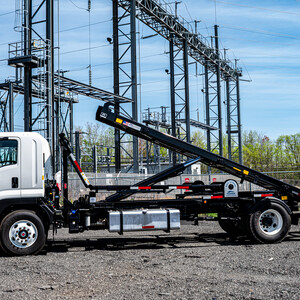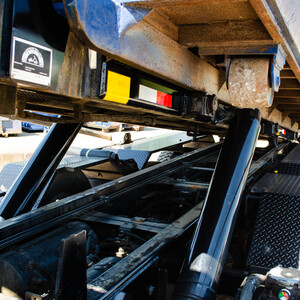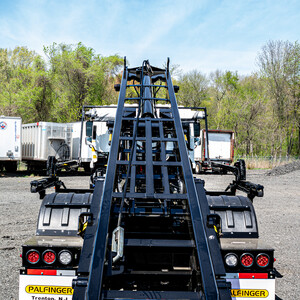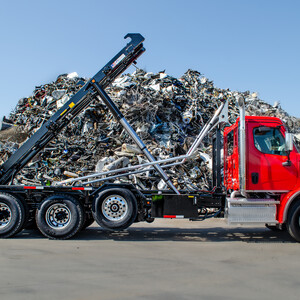
- Home
- News
8 Critical Things You Need To Know About Cable Hoists
What is a roll-off cable hoist?
A roll-off cable hoist is a type of lifting equipment used to lift and lower heavy loads from a roll-off truck and is the most common hoist used today in the United States. Best known for loading, unloading and dumping open-top dumpsters. The hoist consists of a tight and loosened cable through an integrated pully system. This system comprises multiple sheeves and a hydraulic reeving system that drives the cable's tension. This makes it easy to load and unload materials from the truck, even if they are too heavy or large to be lifted by hand. This hoist style has capacities ranging from 12,000 – 75,000 lbs.
How does a roll-off cable hoist work, and when do you use it?
A roll-off cable hoist is designed to pull a body or container onto the truck through a guided rail system. First, the front of the hoist platform is raised to 48-56 degrees. The cable is then hooked to the bottom center of the body or container to set up the next stage of pulling the load. The reeving cylinder then extends, which drives a pully system that pulls the container towards the front of the hoist. Once the container is past the center of the rear wheels, the hoist is lowered, and the container is pulled into the locking system at the front of the hoist.
To use a roll-off cable truck, you will need to follow these steps:
- Park the truck in a level area
- Raise the bed of the truck using the cable hoist
- Load the materials onto the bed of the truck
- Lower the bed of the truck using the cable hoist
- Drive the truck to its destination
- Raise the bed of the truck at the destination
- Unload the materials from the truck
What are the benefits of using a roll-off cable hoist?
There are many benefits to using a roll-off cable hoist, including the following:
- They can lift heavy loads
- They can be used to lift loads over long distances
- They are versatile and can be used in a variety of applications
- They are reliable and efficient
- They are easy to operate
Types of Cable Hoists
- The most popular is the traditional "Fixed Tail" hoist. When loading a container, the tail section of the hoist will touch the ground, acting as a stabilizer.
- Next would be an "Extendable Tail Hoist," sometimes called a "Stinger Tail ." This hoist has a tail section that moves in and out hydraulically. This style is mainly used for towing a trailer using a slightly shorter container. It is also used when picking up containers with low overhead clearance, such as a building. The tail will extend outward farther than required to touch the ground, thus enabling a lower pick-up angle.
- The least popular would be a "Dead Lift" hoist. This is similar to a standard cable hoist, except it does not have a tail section. Instead, this style will lift a container straight off the ground onto rollers at the rear of the hoist frame. From there, it will slide on the container in the same manner as a fixed tail hoist.
- This style is primarily used in the Chicago area because it requires less space to align itself with the container.
What makes a cable hoist different from a hook lift?
Generally speaking, cable hoists and hooklifts perform the same function; they pick up containers and can dump them. The cable hoist uses a cable that the vehicle's driver physically gets out of the truck to attach to the container. A hooklift has a hydraulic arm that the driver operates from inside the cab without getting out of the truck. However, it is always advisable to have the cable driver or hook-lift driver check to ensure the container door is locked before loading the container.
What are the risks of using a roll-off cable hoist?
As with any lifting equipment, some risks are associated with using a roll-off cable hoist. These risks include:
- Overloading the hoist
- Dropping the load
- Cable breaking while operating
- Leaving the hoist up while transporting
It is essential to take all necessary safety precautions when using a roll-off cable hoist. This includes:
- Always inspect your cable and safety equipment before each use
- Always wear safety glasses and gloves when using a cable hoist.
- Keep children and pets away from the area where you use a cable hoist.
- Do not attempt to repair a cable hoist yourself. Instead, if the hoist is damaged, take it to a qualified technician for repairs.
- Do not overload the truck
- Do not operate the truck if it is damaged
- Be aware of your surroundings when operating the truck
By following these safety precautions, you can help to prevent accidents and injuries when using a roll-off cable hoist. We have numerous options to fit your needs. Check out our full line of mechanics trucks that can handle the unique needs of your industry.










